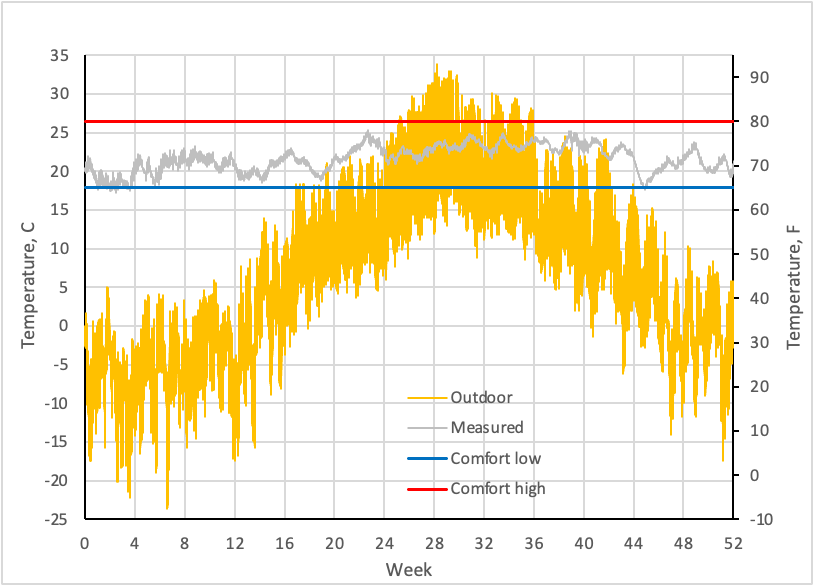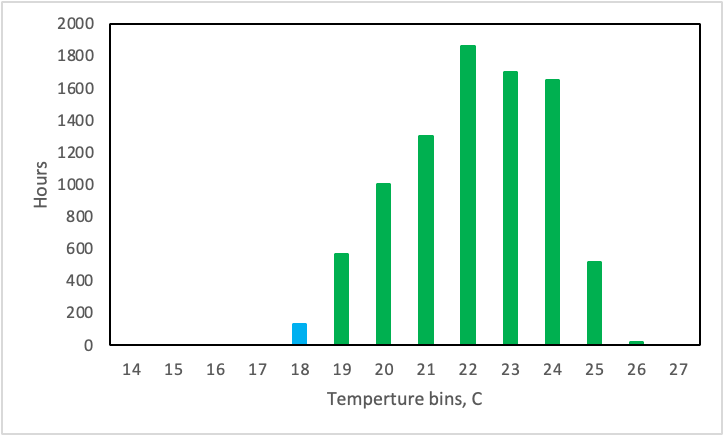Original Message:
Sent: 1/21/2025 11:22:00 AM
From: M Keith Sharp
Subject: RE: Pagosa Springs Ambient House performance for 2024
Timothy,
We have to keep in mind that early IR cameras cost thousands of dollars (back when a thousand dollars was a LOT of money) and required a liquid nitrogen fill just prior to use. Today's technology is better and cheaper, and we don't have to bring a nitrogen tank along.
The phone attachments look nice, but stand-alone cameras are available that are in some cases less expensive. I see some options for less than $100. That said, I don't have experience with the new IR cameras. If anyone has recommendations, I would be interested in hearing them.
I use a non-contact IR thermometer occasionally. It simply gives a temperature reading, and provides a convenient way to check temperature variations around the interior of the house.
------------------------------
M Keith Sharp
Emeritus Professor
Louisville KY
------------------------------
Original Message:
Sent: 01-20-2025 01:57 PM
From: Timothy Mcbride
Subject: Pagosa Springs Ambient House performance for 2024
Keith while thinking about your post and common house insulation, and weatherization, and doing some research, got to wondering about an App or device that can detect infrared thermal imaging with a standard smart phone for detecting infrared heat escape from walls; however, to achieve this functionality seems you need to purchase a dedicated infrared thermal imaging camera attachment for your phone, which then works with a specific app like "Seek Thermal" or "FLIR One" to visualize heat patterns and identify areas of heat loss on walls. Do you use or have any other less expensive technology for average homeowners and DIYers to detect heat loss along these lines? Otherwise the commercial infrared thermal imaging devices are very pricey.
------------------------------
Timothy Mcbride
CEOOwner
Sol-Era R & D
Original Message:
Sent: 01-18-2025 11:18 PM
From: M Keith Sharp
Subject: Pagosa Springs Ambient House performance for 2024
Yes, it all begins with insulation. Passive House does this part really well. But it is more than that. The other things are just enough solar gain, but not too much, sufficient thermal mass, and passive cooling.
Yes, codes could make all the difference. It is encouraging that Passive House standards are being adopted in several states: (https://passivehousenetwork.org/codes/?srsltid=AfmBOooREbA5-1ZGHtYC3JeNEhXombU_xjEGmkA6bvwd0OtHu6UtqBx6) Still lots more progress to be made.
PA is pointed out as having a critical mass of Passive House professionals: (https://zeroenergyproject.com/2023/05/16/top-policies-that-propel-passive-house-in-north-america/) so there are builders in your state who do it.
Houses like this should not be thought of as only for the wealthy. Like many other energy-saving technologies, they cost more up front, but pay back in the long run. Jim Riggins did a thorough job of quantifying costs for his house (see his recent article in Solar Today). The extra cost to offset almost all space heating and cooling and water heating was only 8% of the total cost of the house. Similar numbers date back to the passive solar houses of the 70's (Balcomb reported 4-8% extra to offset a smaller fraction of space conditioning alone).
There are reasons why a modern Ambient House can be even more economical. Compared to the historic passive solar houses, such a house uses more insulation, but less concrete and fewer windows, which tend to be the expensive items. Entirely eliminating furnaces and heat pumps also saves money.
------------------------------
M Keith Sharp
Emeritus Professor
Louisville KY
Original Message:
Sent: 01-17-2025 11:56 PM
From: william fitch
Subject: Pagosa Springs Ambient House performance for 2024
Very nice. Stable. In real-estate it is location, location, location. In housing its insulation, insulation and insulation.
It is a shame that the building codes are so far short of these parameters, because it is the codes that drives the 99% of the NEW created housing. Builders build as fast as they can as as cheap as they can. They will go as low as they can in everyway.
Until the codes require that level of insulation, only the wealthy and of those them care about environment and happen to have a builder that promotes this rather then running the other direction, the majority will remain way behind where we need to be.
Nice data set though....
------------------------------
william fitch
Owner
www.WeAreSolar.com
Original Message:
Sent: 01-17-2025 10:32 PM
From: M Keith Sharp
Subject: Pagosa Springs Ambient House performance for 2024
It has been a while since I have posted data from our house. Below is hourly indoor temperature for 2024. January was the most challenging month, with the lowest outdoor temperatures and also many cloudy days. 2024 performance was overall pretty good (see the histogram), with only 134 hours below our lower comfort limit of 18C = 65F (the blue 17 -18C temperature bin on the left). We used a fire in the fireplace for a total of 19 hours, mostly in January. No overheating occurred. No mechanical heating or cooling.
If the upper and lower comfort limits are too high or low (respectively) for you, an entirely ambient-conditioned house can be designed for a narrower range. Such a house would likely require primarily more thermal mass, but also perhaps more insulation, larger solar gains (for higher low limit), and/or greater ventilation cooling (for lower high limit).


------------------------------
M Keith Sharp
Emeritus Professor
Louisville KY
------------------------------